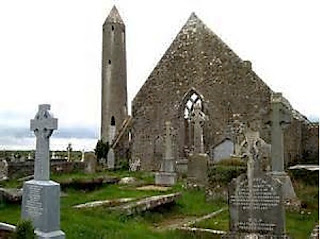By Aidan O'Shea © 2015 A Round Tower in The Burren
Scattered across Ireland are the remains of sixty-five round towers (Cloigtheach or belltower). Many are ruinous but some are intact. Soaring as high as 34 metres above the ground, the towers are in remarkably fine condition considering our turbulent history of invasions and seizures. Scholars have suggested that the probable construction period was between the 7th and 12th centuries AD, and this hypothesis is based on the fact that most are at the site of an early Celtic church dating from the 5th to 12th centuries. Initially each of the towers was a freestanding structure but in later times other buildings, namely churches and monastic foundations, were constructed close by.
The principles used in construction of the towers are always the same: two walls of block and mortar construction are built a few feet from one another and the space between is filled in with a core of rock rubble. This was a standard method of wall construction utilised by the Romans.
With the passage of time, the round tower has come to symbolise Ireland itself, together with the harp, the shamrock and the mythical figure of Hibernia. Towers reach up to the sublime, the heavens, the divine.
Colmán the Hermit.
Cill Mac Duach (Kilmacduagh), Galway, is the tallest of the Irish towers at 34 metres. The monastery's founder, Colmán Mac Duagh, was educated by Enda of Aran on Inishmore and lived there as a hermit. He built a church, Teampall Mór Mhic Duagh, and a small oratory, Teampall Beag Mhic Duagh, near Kilmurvy. These form part of a cluster known as the Seven Churches, although the designation does not indicate the number of churches today, as many were destroyed by the forces of Cromwell in the 17th century.
In the year 690, Colmán accompanied by a servant moved to the Burren, which was then covered in forest. The rolling hills of the Burren are composed of limestone pavements with criss-crossing fissures known as "grikes", leaving isolated rocks called "clints". The region supports arctic, Mediterranean and alpine plants side-by-side, due to the unusual environment. The limestone, which date from the Visean stage of the Lower Carboniferous, formed as sediments in a tropical sea approximately 350 million years ago. The strata contain fossil corals, crinoids, sea urchins and ammonites.
King Guaire had his principal place of residence nearby at Kinvara. He was so impressed with Colmán's holiness that he asked him to take episcopal charge of the territory of the Aidhne. In 610, he founded the monastery, which became the centre of the tribal Diocese of Aidhne. Although reluctant to accept the title, Colmán was ordained a bishop. King Guaire is remembered in the full title of the local town, Gort Inse Guaire. Tradition tells us that Colmán asked God to show him where to build the monastery. Next day, while walking through Burren forest, his girdle fell off. He took this to be God's reply and built the monastery in that place. Colmán died on October 29, 632. The girdle was said to be studded with gems and was held by the O'Shaughnessy clan centuries later, along with St. Colmán's crozier, or staff. The girdle was later lost, but the crozier came to be held by the O'Heynes and may now be seen in the National Museum of Ireland.
This site was of such importance that it became the centre of a new diocese under the rule of Rome, the Diocese of Kilmacduagh, in 1132. The monastery, because of its wealth and importance, was plundered several times in the 13th century. A monastery for the Augustinian order was constructed later in the 13th century under Bishop Maurice.
Destruction.
Monastic life in Britain and Ireland was later to suffer a catastrophic orgy of royal seizure and destruction. The Dissolution of the Monasteries was a set of administrative and legal processes between 1536 and 1541 by which Henry VIII disbanded Catholic monasteries, priories, convents and friaries, appropriated their income, disposed of their assets, and scattered their communities. The site at Cill Mac Duach was granted to Ulick na gCeann Burke, Earl of Clanricarde and the monks dispersed. Burke had submitted to the king at Greenwich in exchange for the earldom.
The extensive cluster of ruins at the site includes: The abbey church, former cathedral, or Teampall Mór, in the graveyard, Teampall Muire (also known as "The Lady's Church"), east of the road, Teampall Eoin Baiste (John the Baptist), to the north of the graveyard. The "Abbot's House" or Seanchlochis further north, close to the road, Teampall Beag Mac Duagh, south of the graveyard and "O'Heyne's Church" 180 metres north-east of the graveyard (13th century).
Finally, the round tower (Cloigtheach) stands roughly 15 metres south-west of the cathedral. The tower is notable both as a fine example of this particularly Irish feature but also because of its noticeable lean, over half a metre from the vertical. The tower is 34 metres tall with the only doorway some 7 metres above ground level. It probably dates from the 10th century. The tower was repaired in 1869 under the supervision of Sir Thomas Deane (late of Cork), with financial support from Sir William Henry Gregory of Coole Park. He was the husband of Lady Augusta Gregory, co-founder of Ireland's National Theatre, The Abbey. The Diocese of Kilmacduagh is now incorporated into the Diocese of Galway.
A few miles away, the poet W. B. Yeats settled in another tower, Túr Ballylee (16th century) and in his verse play, The Dreaming of the Bones, he muses on this very landscape:
I can see The Aran Islands, Connemara hills
And Galway in the breaking light; there too
The enemy has toppled roof and gable
And torn the panelling from ancient rooms;
What generations of old men had known
Like their own hands, and children wondered at,
Has boiled a trooper's porridge.



No comments:
Post a Comment